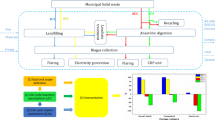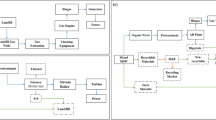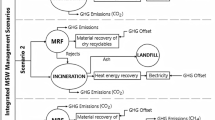Abstract
The final disposal of urban solid waste has become a major concern in a world where urbanization is a trend. In this study three different systems were analyzed by accounting renewable, non-renewable and paid resources in a common basis, with the emergy accounting methodology, so it is possible to obtain ratios and indices that aid the comprehension, management and enable the comparison among the three system: landfill, pyrolysis and plasma arc. The systems are now operating, except for the arc plasma, which is under implementation in the municipality of Hortolândia-SP. The indices show that the landfill with electricity production is the system with better performance for 5 out of 6 indexes. For every gram of USW treated, the landfill can produce \(1.78\,\times \,1016\) joules of electricity, which means that this system is 5 times more efficient than the pyrolisis and the plasma arc systems in this scope.
You have full access to this open access chapter, Download conference paper PDF
Similar content being viewed by others
Keywords
1 Introduction
During the Agenda 21 meeting of the United Nations [1], the majority of the countries committed on adopting policies that would lower the environmental impacts caused by the Urban Solid Waste (USW), based on the principles of sustainable development.
In Brazil Law 12.305/10 was sanctioned, which says about the Solid Waste National Policy [2] and stablishes the recovery of materials and the decrease on waste generation. Concerning to the treatment, Law 12.305 enforces that waste must be either treated thermally or disposed in landfills. Considering that USW is a heterogeneous fuel, this energy could be recovered either as biogas on landfills or gas from synthesis on thermal treatments.
The generation of electricity in one of the landfills has been occurring since the 1070’s [3]. The organic matter is decomposed by methanogenic bacteria, which release biogas that will be converted into electricity on combustion engines. Plasma torch as a technology for USW treatment started to be used in the 1980’s on the United States, Europe and Japan [4]. The organic share of waste is converted into synthesis gas (syngas) in a reactor where the temperature may reach up to 10,000 \(^{\circ }\)C. Afterwards, syngas goes through a cooling and cleaning process and is used for producing electricity on turbines [4].
On the pyrolysis process the waste is decomposed on the pyrolytic reactor, where the chemical decomposition occurs due to the heat of waste, without oxygen and in temperatures ranging from 400 \(^{\circ }\)C 1000 \(^{\circ }\)C [5]. The CUW (Carbonized Urban Waste) from this process goes through a process of briquetting and pressing that will feed the pyrolytic reactor [6].
Researches using Life Cycle Assessment (LCA) stress that pyrolysis, gasification and plasma torch are more efficient for energy recovery, if compared to the incineration process [5, 7], and the landfill should be the last option to be considered (PNRS, 2010).
Several studies employ the emergy synthesis to assess the possibilities, limitations, potentialities and the sustainability of USW treatment technologies, for example: [8,9,10,11,12].
2 Methodology
2.1 System Description
Landfill São João occupies 80 hectares in the municipality of São Paulo and has received 29 million tons of USW during the 17 years it has worked. In 2008, one year after it was closed, São João Energia Ambiental was implemented and started producing electricity capable of fulfilling the demand of a city with 400,000 inhabitants.
Projeto Natureza Limpa is located in the municipality of Unaí-MG. It started operating in 2014 and uses pyrolisys technology to treat 17,500 ton/year of USW. It occupies 18,000 m\( ^{2} \) and has daily treatment capacity of 70 tons of USW, operating 16 hours per day, 365 days per year. The coal obtained (CUW) is used as a feedback to the pyrolytic reactor and the exceeding production is sold on the market.
The plasma torch technology is under studies for implantation in a project designed for the municipality of Hortolândia-SP. The design aims to treat 94,900 ton/year in 30,000 m\( ^{2}\) – 200 ton/day of USW and 60 ton/day of waste from industry, hospitals and sewage sludge, operating 22 hours per day and 256 days per year.
2.2 Methodology
Emergy synthesis is a methodology developed by Odum in the early 80’s. Emergy (spelled with M) is defined as the energy demanded, direct or indirectly, to obtain a good or service, and it s unit is the sej (joules of solar emergy). All the inputs for implementing and operating the system, characterized as energy flows, are converted into a common basis, called joules of solar emergy (sej), for which calculation we use the transformity (sej/J) if the flows are expressed in joules or the UEV (Unit Emergy Value) if the flows are expressed in other measures (sej/unit). This conversion enables to include on the global accounting of the system all the work performed by the men, as well as that performed by nature to obtain each flow of the system.
The emergy accounting table enables to determine the transformity and/or UEV of the good or service under study. The UEV may be used as an indicator of efficiency: a high value would say that the system has made a great effort to obtain one unit of the good or service.
The emergy synthesis, according to [13], is performed in four stages: designing the diagram of energy flows, building the environmental accounting table, calculating the indicators (Table 1) and discussion of the results.
3 Results and Discussion
Every interaction within the treatment systems during the processes, as well as with the landscape may be observed on the diagrams. The energy diagram for the landfill is showed on Fig. 1, the plasma torch system on Fig. 2 and the pyrolysis on Fig. 3.
On Table 2 the results of the emergy accounting for each system, as well as the yearly amount of USW treated in each system.
The electricity on the operation stage is the most significant flow for the systems of thermal treatment, representing 52% of the total for the pyrolysis and 34.5% for the plasma torch system, due to the reactors of both. On the landfill the most significant flow is the Oxygen (O2), responding for 63.1% of the flows and used to burn methane on the motogenerators (Table 3).
UEV is an indicator that may be used to compare the efficiency of the waste treatment system. It comprehends the ratio between the emergy used by the system and the total emergy of the treated USW for this indicator the plasma arc is three times more efficient than the pyrolysis system to treat 1 g of USW and about 2.5 times more efficient if compared to the landfill. Table 4 shows two indicators: Net Emergy and Recovered Emergy. The latter highlights that the landfill recovers 4.59\(\,\times \,\)109 sej per gram of treated USW. The landfill is about 30 times more efficient on emergy recovery when it is compared to the pyrolysis system and about 26 times more efficient compared to the plasma arc. For the Net Emergy indicator the landfill has also shown the best performance: it is 30 times more efficient than the plasma arc system and 198 times more efficient than the pyrolysis.
The results for Recovered Energy, Emergy Investment Recovery (EIR) and Emergy Balance are shown. The landfill is the system which recovers the greatest amount in joules of energy per gram of USW – about 8.5 times more than the other systems. Recovered emergy is the ratio between the recovered emergy and that one used to treat one gram of USW. This indicator stresses that the plasma arc system is 3.5 times more profitable in terms of emergy than the pyrolysis system, as it is able to recover more of the invested emergy due to the greater production of energy per gram of treated USW. For the indicator Emergy Recovery Index, the landfill showed to be 12.5 times more efficient that the pyrolysis system and this relations is 3.5 times greater compared to the plasma arc system (Table 5).
For the Emergy Balance, the system that obtained the best index was the pyrolysis, 2 times more efficient than the plasma arc system and 8 times more efficient when compared to the landfill with electricity generation. Regarding that the landfill is the waste treatment system that obtains the greatest amount of energy joules per gram of treated waste, it means, that recovers more energy on its product and which recovered energy is considered a component for calculating most of the indicators, it is possible to say that the landfill with electricity production is the most effective option to recover or generate energy from USW. It is also the treatment system that has the greatest share of renewable resources (about 60% of O2).
References
CNUMAD. http://www.mma.gov.br/estruturas/agenda21/_arquivos/cap01.pdf
Brazil: Política Nacional de Resíduos Sólidos: Lei 12.305 de 02 de agosto de (2010). www.planalto.gov.br/ccivil_03/_Ato9.2007--2010/2010/Lei/L12305.htm
Tammemagi, H.Y.: The Waste Crisis: Landfills, Incinerators, and the Search for a Sustainable Future. Oxford University Press, New York (1999)
Ducharme, C.: Technical and economic analysis of plasma-assisted waste-to-energy processes. Ph.D. thesis, Columbia University, Columbia (2010)
Zaman, A.U.: Life cycle assessment of pyrolysis-gasification as an emerging municipal solid waste treatment technology. Int. J. Environ. Sci. Technol. 10(5), 1029–1038 (2013)
Tôrres Filho, A.: Aplicação do Processo de Pirólise para Valoração, Cogeração de Energia e Tratamento de Resíduos. Ph.D. thesis, Federal de Minas Gerais, Belo Horizonte (2014)
Chakraborty, M., Sharma, C., Pandey, J., Gupta, P.K.: Assessment of energy generation potentials of MSW in Delhi under different technological options. Energy Convers. Manag. 75, 249–255 (2013)
Tiezzi, E.: Analisi di Sostenibilitá Ambientale del Trattamento dei Rifiuti nel Comune di Modena (1998)
Luchi, F., Ulgiati, S.: Energy and emergy assessment of municipal waste collection: a case study. In: Proceedings of the 1st Biennial Emergy Analysis Research Conference, pp. 303–316. University of Florida, Gainesville (2000)
Bastianonil, S., Porcelli, M., Pulsellil, M.F.: Emergy evaluation of comporting municipal solid waste. WIT Trans. Ecol. Environ. 56, 243–252 (2002)
Rugani, B., Pulselli, R.M., Niccolucci, V., Bastianoni, S.: Environmental performance of a XIV century water management system: an emergy evaluation of cultural heritage. Resour. Conserv. Recycl. 56(1), 117–125 (2011)
Zhang, X.H., Deng, S., Jiang, W., Zhang, Y., Peng, H., Li, L., Yang, G., Li, Y.: Emergy evaluation of the sustainability of two industrial systems based on wastes exchanges. Resour. Conserv. Recycl. 55(2), 182–195 (2010)
Odum, H.T.: Emergy and Environmental Decision Making. Wiley, Hoboken (2005). http://www.wiley.com/WileyCDA/WileyTitle/productCd-0471114421.html
Acnowledgement
CAPES, UNIP and IFSULDEMINAS, RGT International, Projeto Natureza Limpa as well as Alexandre Citvaras (Fox Ambiental).
Author information
Authors and Affiliations
Corresponding author
Editor information
Editors and Affiliations
Rights and permissions
Copyright information
© 2016 IFIP International Federation for Information Processing
About this paper
Cite this paper
Frimaio, G., Frimaio, A., Frimaio, C.A., Almeida, C.M.V.B. (2016). Urban Solid Waste: An Analysis of Energy Recovery Efficiency Three Different Treatment Systems in Brazil. In: Nääs, I., et al. Advances in Production Management Systems. Initiatives for a Sustainable World. APMS 2016. IFIP Advances in Information and Communication Technology, vol 488. Springer, Cham. https://doi.org/10.1007/978-3-319-51133-7_94
Download citation
DOI: https://doi.org/10.1007/978-3-319-51133-7_94
Published:
Publisher Name: Springer, Cham
Print ISBN: 978-3-319-51132-0
Online ISBN: 978-3-319-51133-7
eBook Packages: Computer ScienceComputer Science (R0)







